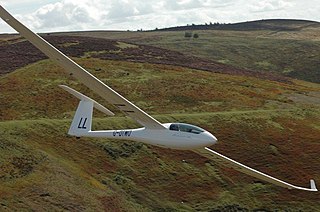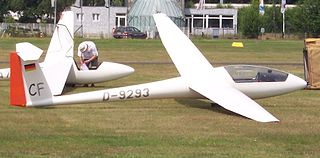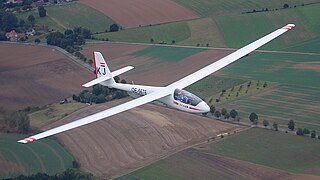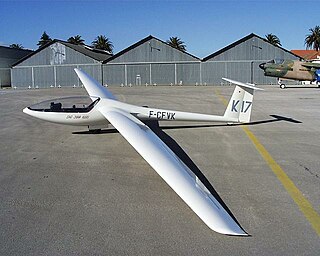
The Schempp-Hirth Discus is a Standard Class glider designed by Schempp-Hirth. It was produced in Germany between 1984 and 1995 but has continued in production in the Czech Republic. It replaced the Standard Cirrus. It was designed by Klaus Holighaus.

The Schempp-Hirth Discus-2 is a Standard Class sailplane produced by Schempp-Hirth since 1998. It replaced the highly successful Schempp-Hirth Discus.

The Rolladen-Schneider LS6 is a 15 metre and 18 metre single-seat flapped glider manufactured by Rolladen-Schneider Flugzeugbau GmbH between 1984 and 2003.

The Rolladen-Schneider LS7 is a high-performance Standard Class single-seat sailplane produced by Rolladen-Schneider Flugzeugbau GmbH from 1988 to 1993.

The Rolladen-Schneider LS3 is a 15 metre single-seat glider produced by Rolladen-Schneider from 1976 to 1983.

The Schempp-Hirth Mini Nimbus is a 15 Metre-class glider designed and built by Schempp-Hirth GmbH in the late 1970s.

The Rolladen-Schneider LS1 is a Standard Class single-seat glider manufactured in Germany by Rolladen-Schneider from 1968 to 1977.

The Standard Cirrus is a Standard-class glider built in Germany by Schempp-Hirth. The Standard Cirrus was produced between 1969 and 1985, when it was replaced by the Discus. Over 800 examples were built, making it one of the most successful early fibreglass glider designs.

The Rolladen-Schneider LS9 is an 18 metre single-seat motor glider launched in 2000 by Rolladen-Schneider. Production ended after just 10 gliders were built, when Rolladen-Schneider went into receivership.

The ASW 28 is a Standard Class glider with a fifteen-metre span built of modern fibre reinforced composites. The manufacturer of the ASW-28 is Alexander Schleicher GmbH & Co. The 'W' indicates this is a design of the influential and prolific German designer Gerhard Waibel. Serial production started in 2000.

The Schleicher ASW 15 is a single-seat sailplane designed in 1968 by Gerhard Waibel and manufactured by Alexander Schleicher GmbH & Co. The ASW 15 has shoulder-mounted wings and an all-flying tailplane, with its single tow-release placement a compromise between winching and aerotowing. The later ASW 15B had several improvements, including a tow-release placed on the plane of symmetry, an 11 cm taller rudder, a slightly larger main wheel, and the provision of a 90-litre water ballast system.

The Glaser-Dirks DG-300 is a Standard Class single-seat high-performance glider built from glass-reinforced plastic. The DG-300 was designed by Wilhelm Dirks and manufactured by Glaser-Dirks Flugzeugbau's Slovenian partner company Elan (company). A total of 511 of all versions were built since production started in 1983. Representative contemporary types from competing manufacturers are the Rolladen-Schneider LS4 and the Schempp-Hirth Discus.

The ASW 19 is a single-seat glider built by Alexander Schleicher GmbH & Co, first flying in 1975. It was originally designed as a Standard Class glider, but now mainly competes in the Club Class. The ASW 19 is known for its pleasant handling and some clubs use it as a training glider. It was succeeded by the all-new Schleicher ASW 24.

The G102 Astir is a single-seat glassfibre Club Class sailplane, designed by Burkhart Grob and built by Grob Aircraft. It was the first Grob-designed sailplane, with the first flight in December 1974. Grob had previously built the Schempp-Hirth Standard Cirrus under licence.

The Schleicher ASK 18 is a single-seat sailplane that was built by the German manufacturer Alexander Schleicher GmbH & Co. It was designed to be a sturdy aircraft for inexperienced solo pilots and so uses a simple and rugged construction and has docile handling characteristics.

The Grob G104 Speed Astir was a competition sailplane produced in Germany in the late 1970s as Grob's first design in the 15 metre class.

The SZD-59 Acro is a single-seat glass composite glider for aerobatics and cross-country flying by PZL Allstar of Bielsko-Biała, Poland.

The SZD-41 Jantar Standard was a Standard Class glider designed and produced in Poland from 1973.


















